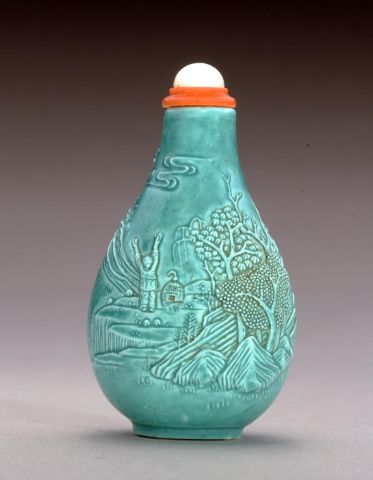
Bottle ID: 358
MOLDED GREEN XINQUAN
Date: 1819
Height: 65 mm
Porcelain, covered overall in clear turquoise-green enamel, of flattened pear-shape tapering to a cylindrical neck, with a wide mouth, and with a recessed oval foot, carved in relief and with incising, with a continuous design of Bao Lin releasing a magpie into the wild, its cage at his side as he stands with arms outstretched, facing towards the flying bird, who looks back, poignantly, at him, the scene set in a rocky landscape with trees and distant hills; and inscribed in regular script ‘Baolin Yang Bao of the later Han dynasty sets free a titmouse, and receives jade rings, made by Xinquan in the Wheat Harvest Autumn (fourth month) of 1819’, the foot and lip also enameled in green.
Xinquan, attributed to Jingde Zhen.
Similar Examples:
Moss, Hugh, Victor Graham and Ka Bo Tsang. The Art of the Chinese Snuff Bottle - The J & J Collection, 1993, Vol. I, pp. 419-420, no. 251.
Hidden Treasures of the Dragon - Chinese Snuff Bottles from the Collections of Humphrey K. F. Hui, Margaret Polak and Christopher C. H. Sin. 1992, p. 92, no. 181.
Miller, Tony and Humphrey Hui. Elegance in Relief: Carved Porcelain from Jingdezhen of the 19th to Early 20th Centuries, 2006, p. 124, no. 19.
Provenance:
Hugh Moss (HK) Ltd.
Dr. Giovanni Caretti
The Ko Collection, Jinanfu, 1925
This is one of a very small group of signed masterpieces by Xinquan, the early nineteenth century porcelain carver from Jingde Zhen. Only two other signed examples are known, dated to 1821 and 1824, making this example highly important, being the earliest known example of carved porcelain. The one in the J and J Collection has the same colored glaze and is incised with a precise date to 1821 (also of the Daoguang period). The inscription on that bottle reads: "Made in the late Spring month of the year xinsi, while sojourning at Zhushan in Xinping (Jingde Zhen) by Mr. Xinquan". The bottle dated to 1824 is from the Collection of Mrs. Margaret Polak and is decorated with Meng Haoren and his mule in a landscape scene. On the reverse of the bottle the inscription reads: "Made this in the Spring month of the year jiashen, by a southern window in Zhushan at the request of Ziqin". Another bottle which may be by Xinquan is in the Piper Collection (no. 35.1.106) although it bears a different name which is presently unrecorded and which has defied translation. The only known desk object by Xinquan, which is signed but not dated, is a brush pot purchased by Stephen Bushell for the Victoria and Albert Museum in London, which arrived at the Museum in 1883. Its acquisition date is important because it more or less precludes the snuff bottles, with their cyclical dates from being later in the century, unless the brush pot came directly from the kiln to Stephen Bushell. Since Chen Guozhi can be firmly dated to the Daoguang Period it is likely that Xinquan was one of his contemporaries given the similar high artistic standards of their work. The only minor spanner in the works to this dating is that the reference to Zhushan (Jingde Zhen) in the inscriptions is more of a scholarly affectation of the Guangxu Period than of the Daoguang Period.
Bo Lin is a shadowy figure, described as a scholar of the later Han dynasty, associated with a legend where he frees a bird into the wild, but he is not listed in the standard biographical dictionaries, or dictionaries of well known legendary figures.

 English
English 中文
中文